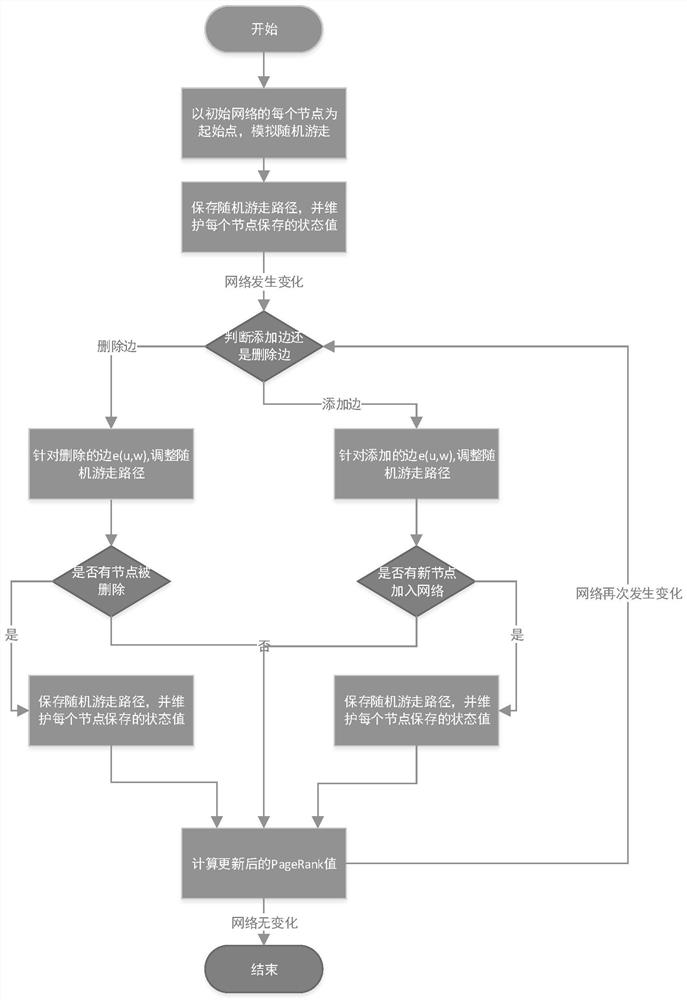A real-time tracking method of dynamic network pagerank value
A real-time tracking and dynamic network technology, applied in data exchange network, network data retrieval, network data query, etc., can solve the problems of difficult PageRank tracking, rapid accumulation of errors, and low algorithm efficiency in dynamic networks
- Summary
- Abstract
- Description
- Claims
- Application Information
AI Technical Summary
Problems solved by technology
Method used
Image
Examples
Embodiment 1
[0034] Embodiment 1: Add a new edge e(u, w) to the network, where both nodes u and w already exist in the network.
[0035] Step 1. For the initial network, each node in the network is used as the starting point, and the reset probability ∈ is used to simulate R random walks. In the embodiment, ∈=0.15, R=8;
[0036] Step 2, for each random walk path obtained in the previous step, assign a unique id, and store it in a hash table in memory with the id as the key value, so that the access to each random walk path The time is O(1), and the id in the implementation is a positive integer starting from 1, and increments by 1 every time it is generated;
[0037] Step 3, for each node u in the network, save S(u), a set that saves the ids of all random walk paths passing through node u; V(u), a positive integer value, saves all random walk paths The number of visits to node u; the specific operation method is as follows,
[0038] Every time a random walk path is added to the hash tabl...
Embodiment 2
[0044] Embodiment 2: Add a new edge e(u, w) to the network, where node u is a node newly added to the network.
[0045] Step 1. For the initial network, each node in the network is used as the starting point, and the reset probability ∈ is used to simulate R random walks. In the embodiment, ∈=0.15, R=8;
[0046]Step 2, for each random walk path obtained in the previous step, assign a unique id, and store it in a hash table in memory with the id as the key value, so that the access to each random walk path The time is O(1), and the id in the implementation is a positive integer starting from 1, and increments by 1 every time it is generated;
[0047] Step 3, for each node u in the network, save S(u), a set that saves the ids of all random walk paths passing through node u; V(u), a positive integer value, saves all random walk paths The number of visits to node u; the specific operation method is as follows,
[0048] Every time a random walk path is added to the hash table, al...
Embodiment 3
[0055] Embodiment 3: Delete edge e(u, w) from the network, where nodes u and w still exist in the network.
[0056] Step 1. For the initial network, each node in the network is used as the starting point, and the reset probability ∈ is used to simulate R random walks. In the embodiment, ∈=0.15, R=8;
[0057] Step 2, for each random walk path obtained in the previous step, assign a unique id, and store it in a hash table in memory with the id as the key value, so that the access to each random walk path The time is O(1), and the id in the implementation is a positive integer starting from 1, and increments by 1 every time it is generated;
[0058] Step 3, for each node u in the network, save S(u), a set that saves the ids of all random walk paths passing through node u; V(u), a positive integer value, saves all random walk paths The number of visits to node u; the specific operation method is as follows,
[0059] Every time a random walk path is added to the hash table, all n...
PUM
 Login to View More
Login to View More Abstract
Description
Claims
Application Information
 Login to View More
Login to View More - R&D
- Intellectual Property
- Life Sciences
- Materials
- Tech Scout
- Unparalleled Data Quality
- Higher Quality Content
- 60% Fewer Hallucinations
Browse by: Latest US Patents, China's latest patents, Technical Efficacy Thesaurus, Application Domain, Technology Topic, Popular Technical Reports.
© 2025 PatSnap. All rights reserved.Legal|Privacy policy|Modern Slavery Act Transparency Statement|Sitemap|About US| Contact US: help@patsnap.com

